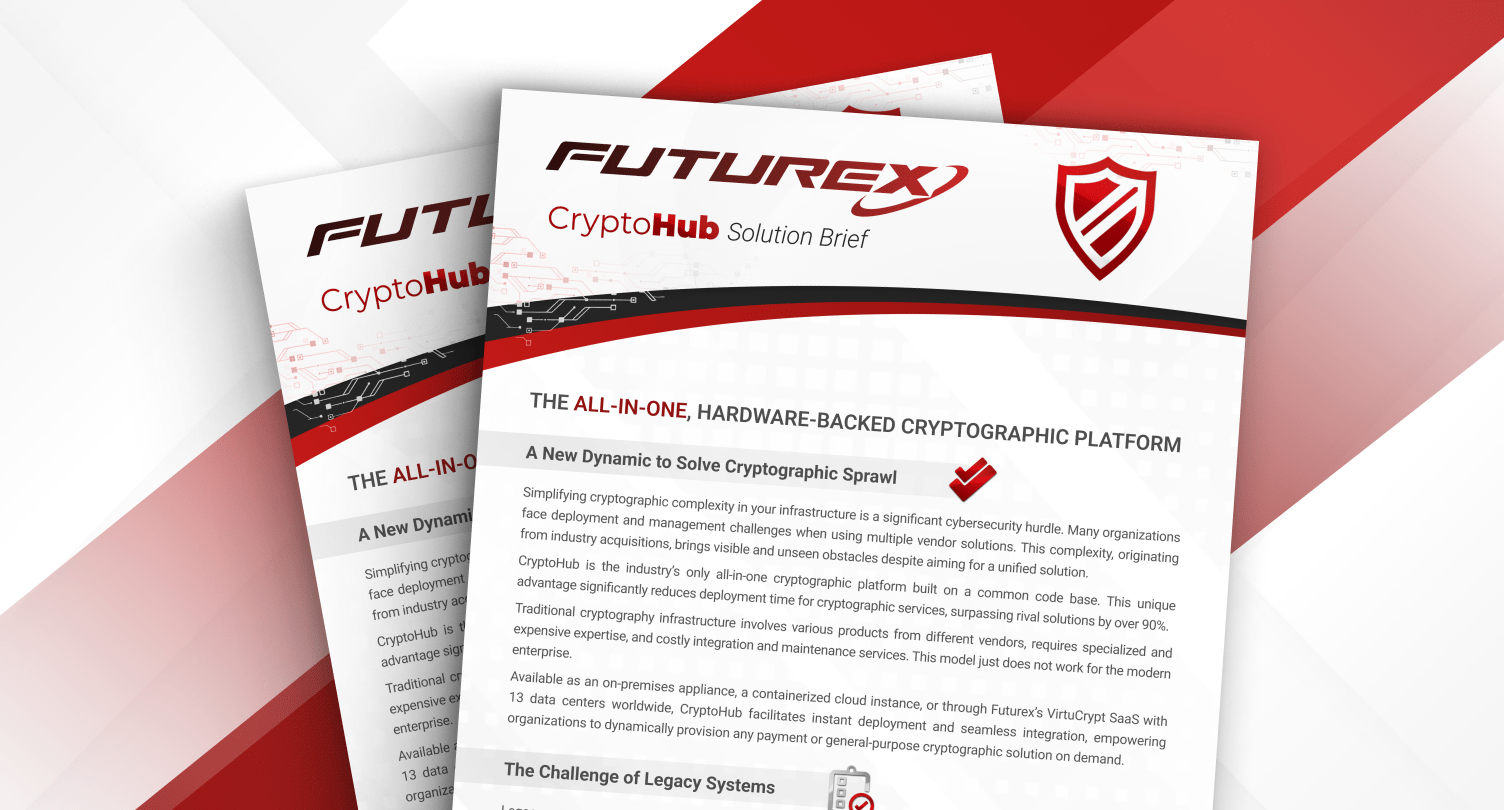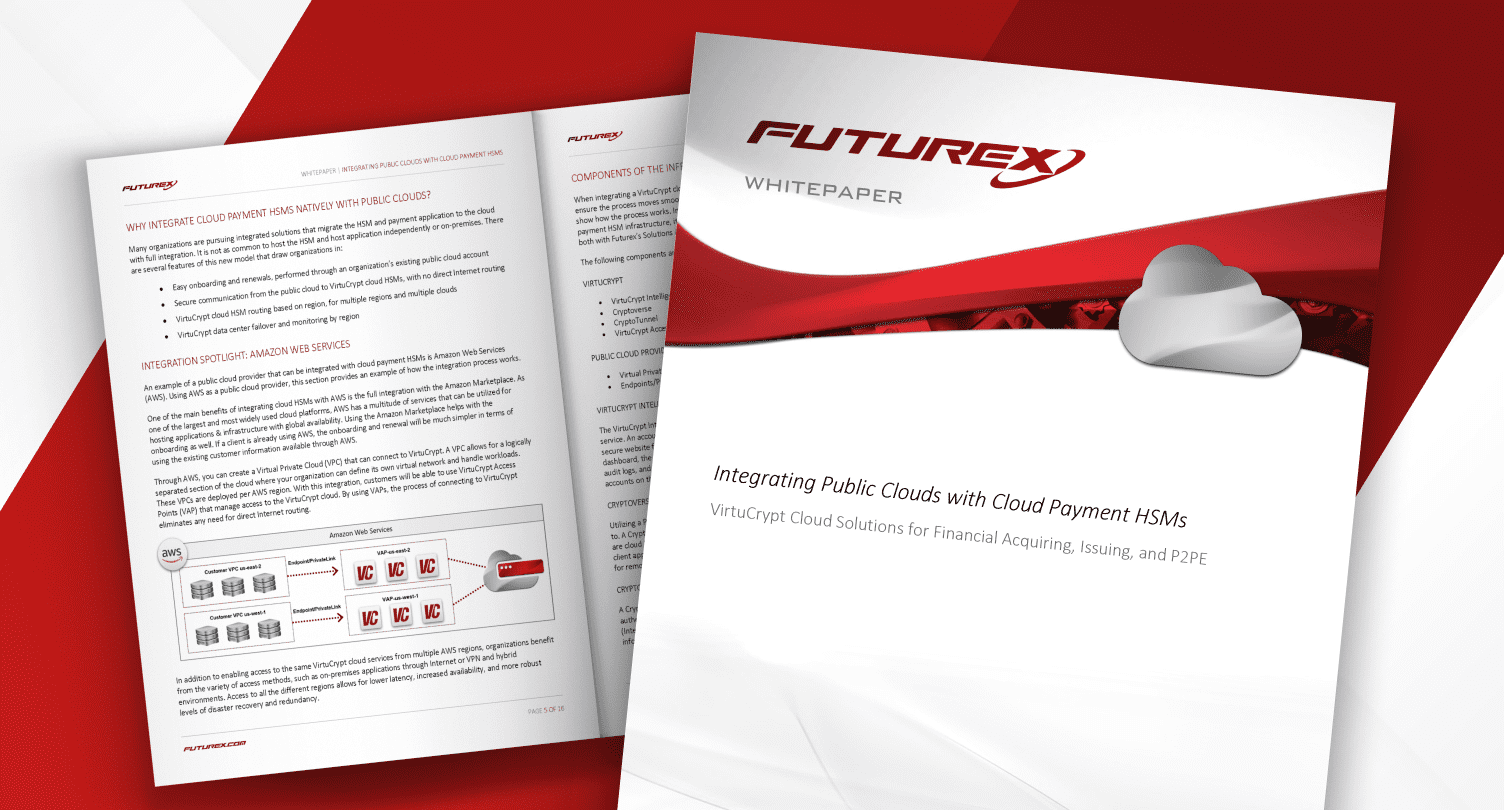Integrations
Seamless integrations for your business solutions

Empower Your Security Ecosystem
With more than 150 applications and integrations with leading technology providers, transform your security landscape with our integrated solutions. From IoT to key injection, database and application encryption, to supporting CI/CD security, our robust HSM capabilities, adaptable across cloud, on-premises, and hybrid environments offer optimal protection.
Futurex equips you with innovative, scalable, reliable, and compliant solutions tailored to your needs. Our extensive integrations ensure your organization remains secure, resilient, and prepared for evolving digital threats. In the interconnected world, Futurex provides cutting-edge security that meets today's standards and anticipates tomorrow's challenges.
Boost Your Ecosystem with Futurex
Comprehensive Integration
Access over 150 applications and integrations with top technology providers, offering seamless compatibility and enhanced functionality across diverse security landscapes for comprehensive protection and flexibility.
Versatile Security Solutions
From IoT to key injection and database encryption, leverage our wide-ranging solutions to address various security needs, ensuring protection at every level of your infrastructure and application ecosystem.
Seamless Application Support
Integrate security seamlessly into your application and database infrastructure, enhancing efficiency and reducing vulnerabilities in your ecosystem.
Adaptable HSM Capabilities
Our robust HSM capabilities are adaptable across cloud, on-premises, and hybrid environments, providing consistent and reliable security solutions regardless of your infrastructure setup, ensuring optimal protection for your data and applications.
Industry-Leading Protection
Benefit from industry-leading security measures, including database encryption and application security, supported by our integrated solutions and HSM capabilities, safeguarding your sensitive data and applications against evolving cyber threats.

3rd Party Integrations
Apache: HTTP Server and Tomcat
The Vectera Plus offers easy integration with Apache HTTP Server and Apache Tomcat web server software.
.png?width=85&height=101&name=vectera%20plus_axway_Q%20(1).png)
Axway
Use the Vectera Plus to validate digital certificates stored on CAC cards, PIV cards and in software, via Axway Validation Authority integration.
HashiCorp Vault: Seal Wrap & Entropy Augmentation and Managed Keys
The Vectera Plus integrates with two services offered by HashiCorp Vault: Seal Wrap & Entropy Augmentation and Managed Keys. Manage secure data vaults for certificates, tokens, credentials, and managed encryption keys.
BIND 9
Integrate with the flexible, open-source BIND 9 DNS software suite. Between the Vectera Plus’s support for numerous APIs and the full-featured BIND 9, integration options abound.
CyberArk Vault
Create and configure secure credential storage vaults with the Vectera Plus. Use the CyberArk Vault integration to protect and manage privileged access across your organization’s on-premises and cloud infrastructure.
EJBCA
Bring high-performance general purpose encryption of the Vectera Plus to your open-source CA and PKI functionality in EJBCA. The platform-independent flexibility of EJBCA matches the many vendor-agnostic APIs supported by the Vectera Plus.
ISC CertAgent
The Vectera Plus includes a range of vendor-neutral APIs which allow it to integrate with the customer-hosted and easy-to-use ISC CertAgent CA to issue X.509 certificates.
Java Jarsigner
Establish digital signing operations for Java JAR files to authenticate them with the Vectera Plus’s support for Java Jarsigner.
Microsoft SignTool
Digitally sign and verify signatures of files with Microsoft SignTool support.
Microsoft Windows Certificate Store
Store certificates on local computers using the Microsoft Windows Certificate Store via the Vectera Plus. Certificate stores can accept certificates from different CAs.
OpenSSL Engine
Easily integrate with OpenSSL to generate private keys and create CSRs with the Vectera Plus.
Protegrity
Connect the Vectera Plus encryption functionality to the data protection capabilities of Protegrity.
Microsoft AD CS
Securely support Microsoft AD CS in creation and management of client Public Key Infrastructure (PKI) certificates by centralizing private key storage in the Vectera Plus hardware security module. For more information on Futurex’s AD CS integration methods, visit our Microsoft AD CS Technology Solutions page, or download our informational brochure.
Oracle Database TDE
Establish a Root-of-Trust (ROT) for Oracle databases in the Vectera Plus HSM and provide critical protection to the wallet password. The Vectera Plus provides high-assurance security for the Transparent Data Encryption (TDE) process without disrupting existing features.
Microsoft SQL Server
Take advantage of the vast set of features and administrative functionality the Vectera Plus HSM provides by using it to offload Transparent Data Encryption (TDE) keys for Microsoft SQL Server. Effectively manage the full key lifecycle, securely generate and issue database encryption keys, and configure specific key management functions like key rotation and aging. Read more about data encryption with SQL Server & HSMs.
Versasec vSEC:CMS
vSEC:CMS is a credential lifecycle management system. When implemented through the Vectera Plus, users can create and manage user authentication credentials throughout their organization.
Java KeyTool
Seamlessly secure keys in the Vectera Plus HSM with Java KeyTool for use in a wide range of general-purpose applications.
Venafi Trust Protection Platform (TPP)
For effective key & certificate lifecycle management, integrate the Vectera Plus HSM with Venafi’s Trust Protection Platform. Visit the Venafi.com Marketplace to download the integration guide and get started.
Red Hat Certificate System
Manage user identities and secure private communications with integration for Red Hat Certificate System. Red Hat integration protects traffic from security risks by streamlining PKI.
Check Point Security Gateway
Integrate the Vectera Plus HSM into a Check Point Security environment to add an extra layer of security to the network. Configure the Check Point Security Gateway to effectively store cryptographic key pairs and distribute Certificate Authority (CA) certificates.
Featured Resources
/ds_thumbnail_cryptohub-min.png)

"...we are working with AWS and Futurex. They help us provide the innovative, scalable, reliable, and compliant solutions our customers are seeking day after day.”
- Thiago Lopes, Information Security Manager
Pismo
Enterprise Data Encryption Solutions
Futurex provides HSMs and key management servers that handle encryption, bring-your-own-key (BYOK). Futurex helps enterprise organizations deploy a modern cloud data security environment that complies with the latest standards and regulations.


